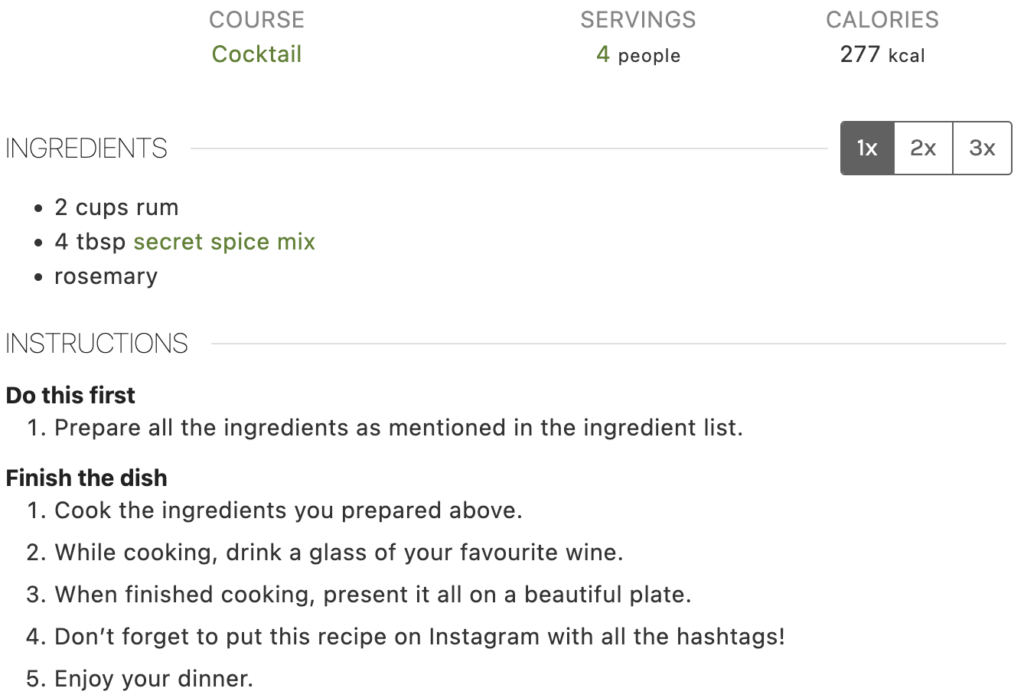Are you an aspiring food blogger? Whether you’ve already started your food blog or are just toying with the idea of launching a new blog, it’s time to start making money from your hard work. Running your own food blog may seem like a hobby to most, but with some effort (and step-by-step guidance from us), you can monetize your blog and start earning a passive income doing what you love.
So, just how much can you earn on your blogging journey? You may have heard about bloggers earning hundreds of thousands of dollars through their food blogs, but most people won’t reach that level. However, with the right tools, it’s certainly possible to earn some extra money from your content.
In this post, we’ll go over just how much money top food bloggers make and how you can boost your blog traffic, get sponsorships, become an affiliate marketer, and make some extra dough (literally and figuratively!).
How Much Do Food Bloggers Make?
There are thousands of food blogs online, and not every blog generates the same amount of money – in fact, some food blogs don’t make money at all. While we don’t know the average food blogger’s salary, there are some statistics available that reveal just how much a successful food blogger makes.
Pinch of Yum shared their monthly income and traffic reports up until 2017, which showed that they made several thousand dollars per month which made it possible for them to make the blog a sustainable business.
There are more recent examples, too. Successful food bloggers who have turned their passion into a living include:
- Tiffy Cooks, who earns 45-55k per month through her food blog (as of October 2021);
- The Clean Eating Couple reported an annual income of $150,000 in 2019;
- Stephanie’s Sweet Treats reported earning $4,739.88-$9,296.88 per month in Q1 2022; and
- The Midwest Foodie Blog reported an income of $64,270 for Q1 2022.
There are also a few celebrity chefs and TV personalities that run their own blogs, like Dennis Prescott and Mary Berg, but their earnings are in an entirely different league to amateur chefs and home cooks as they probably make the bulk of their money through book sales and TV appearances.
The amount of money you make from food blogging will depend on the time and effort you are willing to spend on your blog. While some bloggers will make it big, the vast majority will earn a modest and steady income – and there’s nothing wrong with that. Before you even get started on your blogging journey, take a good hard look at your goals.
Are you planning on turning your food blog into a full-time venture? If so, are you willing to grow your digital marketing and food photography skills? Do you have an alternative and steady source of income to keep you going while you wait for your food blog to take off? Are you willing to invest some money and time in SEO or in Google AdSense and social media marketing?
If not, are you planning on running your food blog as a part-time business or hobby after hours? You probably won’t make as much money as someone who devotes all of their time to growing their food blog, but it’s still possible to monetize your website by following a few strategies.
Let’s look at some of the most common strategies and revenue streams food bloggers turn to in order to build their income.
Which Revenue Streams Are Available to Food Bloggers?
If you want to make money as a food blogger, it’s never a good idea to put all of your eggs in one basket. Diversify your revenue streams as much as possible. Some of these are very simple and can help you build a small but steady passive income. Others, especially sponsorships and affiliate marketing links, may require a little more online and social media presence and networking on your side. By giving you the list below, you can choose which revenue streams make the most sense for your own food blog.

Website Ads
Using online ad networks is the easiest path to monetization. These networks will display ads from third parties on your site. The most common ad networks you’ll use are probably Google AdSense, Mediavine, and AdThrive. All you need to do is sign up to the ad network and install a small line of code on your site to display relevant ads to your site visitors. You can also customize the placement and display of these ads to make sure your site still looks good. Of course, how much you’ll earn will depend on your blog traffic and pageviews.
Keep in mind that you may need to hit certain metrics before you’re approved to join the ad network. Mediavine, for example, requires you to have 50,000 sessions per month before you can get approved with all ad partners.
Affiliate Links
Affiliate links are links to different websites that send customers to a product page where they can purchase the item you’ve mentioned in your food blog (e.g., a link to an Amazon store). You could earn a cut of the sale if you send some of your blog traffic to the site. You can sign up as an Amazon Affiliate or join a major affiliate marketing company like Commission Junction to get started.
Sponsored Posts
Some companies may pay you to put out specific content about their product on your site, for e.g., using their brand in a recipe or discussing the health benefits of the product in a dedicated post. You’ll need good relationships with a few brands to make this work, and make sure that you balance sponsored content with original content so that you don’t alienate your readers.
E-Books
Once you have several recipes in your wheelhouse, you can sell them as an e-book on your food blog or on a site like Amazon using an online ebook creator. It may be time-consuming to launch your e-book, and you need to account for transaction fees you’ll need to pay if you sell your book through an entity like Amazon. However, it could be a good option if your food blog already has a decent following.
Brand Deals
If you’ve grown your blog traffic and content sufficiently, you may hook the biggest fish of all: brand deals. Becoming a brand ambassador not only means free products but bigger contracts and a steady income. You can’t expect to land a big deal in the early months of your blog, but if you keep working at it, brand deals can be lucrative. Be warned, though: brands are particular about how they are portrayed. This can limit your creative freedom a bit, and you’ll need to sharpen your food photography skills considerably. Make sure that you have enough clout to offer a brand by growing your social media audience and newsletter subscribers.
Live Events
Food bloggers with a sizable audience can literally take their show on the road. Why not approach a local food festival or show about offering a live cooking class or demonstration? If you’re lucky, you can find a sponsor and earn a portion of the ticket sales as well.
Merchandise
If you have a flair for design and a few cute slogans, you can sell T-shirts, aprons, and kitchen accessories to make extra money off your site. Instead of buying a ton of merchandise and waiting for orders to arrive, look into drop-shipping options. It’s cheaper, faster, and more profitable.
Ads From Other Platforms
Food bloggers can make money through more channels than just their food blogs. You can make ad revenue on YouTube from the display, overlay, and video ads or through channel memberships where subscribers make recurring payments in exchange for special perks, e.g., recipes and e-books. Keep in mind that you’ll need a thousand subscribers before you can monetize your YouTube channel.
Shoppable Recipes
Shoppable recipes have become really popular during the pandemic. Large grocers and eCommerce companies jumped on this trend, with brands like Walmart partnering with recipe content platforms like Tasty to sell equipment and ingredients directly in a recipe. There are a few plugins that will enable you to add shoppable recipe cards that add an Add To Cart button next to shoppable ingredients. You will earn money in the same way you would using affiliate links.
Which Revenue Streams Should You Get Started With?
The most popular revenue streams for food influencers and bloggers are website ads and affiliate links. It’s also the main source of income for many of the successful food bloggers we’ve mentioned above. The good news is these revenue streams are easy to get started with and explore.
If you are thinking of starting a new food blog and want to make money from it, consider building your site through WordPress and the WP Recipe Maker plugin for food bloggers.

WordPress started as a hub for online blogging, and it’s stayed true to that vision over the years. If you are an aspiring food blogger, you’ll find it easy to start your blog and customize your designs, even if you have no coding or website experience whatsoever. Monetization is easy too. You can run ads by manually inserting ad codes into content fields or by using plugins to display ads, like AdSanity or AdRotate.
Once you’ve built your food blog, make sure you use the WP Recipe Maker plugin to display your recipes. WP Recipe Marker will not only present your food blog in a legitimate and attractive way but give you tons of options to customize your recipe layout through templates, photos, videos, etc. You can even set adjustable serving sizes to make your food blog even more appealing to your audience.

WP Recipe Maker can help you build a passive income through Ingredient Links and Equipment Links in your recipes which you can use to add affiliate links. This means you can earn affiliate revenue from all kinds of food suppliers, online stores, or kitchenware companies.
You can also take advantage of WP Recipe Maker’s integration with Instacart Shoppable Recipes to boost your blog income. Readers in the United States can add the full set of ingredients from one of your recipes to their cart and have it delivered to their door. You’ll earn a commission off the customer’s order – and if you are trying to land a brand deal or create sponsored posts, this can be a compelling proposition for the companies you’re pitching to!
There are SEO benefits that will help grow your blog traffic too. The plugin handles your recipe metadata using the latest JSON-LD structured data standards. It sounds like a lot of jargon, but basically, this standard makes it easier for your recipes to rank on search engines. The higher you rank, the more blog traffic you’ll get, and the more blog income you can make through page views and affiliate links, Google AdSense, and other revenue streams implemented on your pages.
Keep Tabs on Your Expenses
You’ve got to spend money to make money as a food blogger, but don’t forget to track how much money you’re spending on marketing and products if you want to turn your food blog into a full-time job. Some of the most successful food bloggers even end up hiring staff to help run the business, but you shouldn’t consider it until you are turning a solid profit.

The biggest expenses you’ll incur as a food blogger include:
- Annual site costs (e.g., WordPress hosting, WP Recipe Maker, and plugins or themes you might use). If your food blog is really getting traction, consider investing in a decent managed WordPress host like WP Engine so that you maintain your site’s performance and can scale as much as you need to really make money as a foodie.
- Your ingredients, cooking utensils, and other supplies
- Programs you will need to run your blog (e.g., Photoshop to create graphics)
- Ad costs and social media promotion
- Contractors (e.g., if you want services like custom graphics or a photoshoot to promote your brand)
- Taxes
Monetize Your Food Blog with WP Recipe Maker
Whether you are a hobbyist that just wants to cover the cost of your ingredients, or if you have dreams of building a food blogging empire (OK, this goal is less realistic!), you can certainly make money from your food blog with the right marketing techniques and revenue streams.
If you haven’t created your food blog yet, use WordPress and WP Recipe Maker to create a beautiful-looking website. This is a great combo to monetize your site using low-barrier methods such as website ads on your pages and affiliate links directly in your recipes.
Choose your WP Recipe Maker pricing plan and get started today!
FAQs
Is food blogging a profitable niche?
Yes. In fact, food bloggers have a median monthly income of $9169, making it the most profitable out of the major blogging niches.
What’s the average income for a food blogger?
While the amount you can earn as a food blogger varies widely, according to ZipRecruiter, the average pay for a US-based Food Blogger as of March 2024 is $29.94/hour.
Where can I find a detailed breakdown of a successful food blogger’s income?
One of the most popular food blogs out there, Pinch of Yum, has released a number of income and expense reports, which date back to 2011. These are incredibly useful, especially if you’re trying to work out what kind of ROI you can expect once you’ve reached a certain level of success.







Hi Brecht, I am not sure how I stumbled on this, but I am glad I did. I am in shock, 45k-55k a month? That amount was so high I had to pause for a moment.
This is a great guide for folks starting a new food blog. I’d also like to say that it takes a lot of hard work to get to the levels listed in the article. Food blogging is definitely a long-game, so if you’re starting a new blog, it’s nice to know what the future holds.
Definitely takes a lot of hard work and a good amount of luck as well. It’s good to know what’s possible in the long run, but make sure to take one step at a time, when starting out!